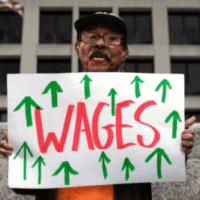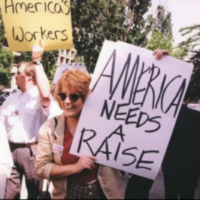This November, Nebraskans will have an opportunity to raise the state’s minimum wage when they head to the polls. Under Initiative 433, the state’s minimum wage would gradually increase to $15 an hour by 2026, with annual cost of living adjustments thereafter. The measure would benefit nearly 150,000 workers, according to estimates by the Economic Policy Institute.
Minimum wage increases are a tried-and-true approach to boosting workers’ paychecks, without negative effects, as the prior experience of Nebraska and neighboring Arkansas and Missouri shows, and as over two decades of economic research demonstrates.
Nebraska has boosted workers’ earnings before, without adverse effects for workers or businesses
In November 2014, Nebraska voters approved a ballot initiative raising the state’s minimum wage to $8.00 in 2015 and $9.00 in 2016. The measure received the support of nearly 60 percent of voters, and the endorsement of diverse communities—from workers and labor groups, individual business owners, and groups representing the interests of rural communities.[1] NELP’s analysis of employment, wage, and business data suggests that the minimum wage increase has not had a negative impact on Nebraska’s economy. These findings are in line with over two decades of economic research on the minimum wage, which finds that higher wage floors raise the earnings of underpaid workers without negative effects on employment.[2]
At the time of passage in 2014, Nebraska’s unemployment rate was 3.3 percent. By the time the state had reached its target rate of $9.00 in 2016, the unemployment rate had dropped to 3.1 percent. During this same time, there were net gains in the number of employed workers (0.5 percent, or 5,250 workers), business starts (4.0 percent, or 42 applications), and the number of businesses (2.7 percent, or 1,807 establishments).
A year later, these positive economic trends continued. The unemployment rate dropped again to 3.0 percent. Between 2014 and 2017, the size of the employed workforce grew by 1.3 percent (13,058 workers); the number of businesses starts increased by 18.9 percent (195 new applications); and the number of businesses grew by 3.1 percent (2,037 establishments). While, based on these numbers alone, we cannot attribute the positive economic trends directly to a higher minimum wage, the data suggests that Nebraska’s 2014 minimum wage law did not have negative impacts on workers or businesses.
| Table 1. Change in total employment, unemployment rates, business applications, and number establishments in Nebraska between 2014-2017 | ||||
| Year | Employment | Unemployment Rate | New Business Applications (Annual Average) | Number of Establishments |
| 2014 | 979,639 | 3.3% | 1,031 | 66,612 |
| 2015 | 981,460 | 3.0% | 1,070 | 67,129 |
| 2016 | 984,889 | 3.1% | 1,073 | 68,419 |
| 2017 | 992,697 | 3.0% | 1,226 | 68,649 |
| Change 2014-2016 | + 5,250 | – 0.2% | + 42 | + 1,807 |
| Change 2014-2017 | + 13,058 | – 0.3% | + 195 | + 2,037 |
| Source: NELP analysis of U.S. Bureau of Labor Statistics, Local Area Unemployment Statistics (employment and unemployment rates); U.S. Census Bureau, Business Formation Statistics (business applications, seasonally adjusted); and U.S. Bureau of Labor Statistics, Quarterly Census of Employment and Wages (number of establishments). Number of establishments refers to the private sector. | ||||
Looking at the lowest paying—and therefore most impacted—industries, we notice a similar pattern of no negative impacts (Table 2). Between 2014 and 2016, employment in the restaurant industry grew by nearly 2,000 workers, aggregate wages increased by over $124 million, and annual wages increased by more than $1,600. The retail trade industry experienced similar increases, with a net gain of over 2,300 workers, $250 million in total additional wages, and over $1,700 in additional annual pay. The health care and social assistance industry outperformed the other two, with a net gain of almost 4,000 workers, $590 million in additional aggregate wages, and more than $3,400 in additional annual pay.
Those numbers were still positive and growing a year later, except for the retail trade industry, which saw a small decline in its employed workforce in 2017—a reflection of nationwide trends (including the rise in e-commerce and discount retailers, and the diversion of more discretionary income towards travel and food services) which led to a nationwide decline in retail employment between 2017 and 2019.[3]
[1]. Ballotpedia, Nebraska Minimum Wage Increase, Initiative 425 (2014), https://ballotpedia.org/Nebraska_Minimum_Wage_Increase,_Initiative_425_(2014). Accessed August 2, 2022.
[2]. See summary of minimum wage research in Laura Huizar, A $12 Minimum Wage: Broad Benefits for Workers and Small Businesses Across Missouri, National Employment Law Project, August 2018, https://s27147.pcdn.co/wp-content/uploads/12-MO-Ballot-Small-Business-Impact.pdf#page=3.
[3]. Daniel Dorfman, U.S. Bureau of Labor Statistics, “Retail Trade Employment: Before, During, and After the Pandemic,” Beyond the Numbers, Vol. 11, No. 4 (April 2022), https://www.bls.gov/opub/btn/volume-11/retail-trade-employment-before-during-and-after-the-pandemic.htm.




